July 17, 2017
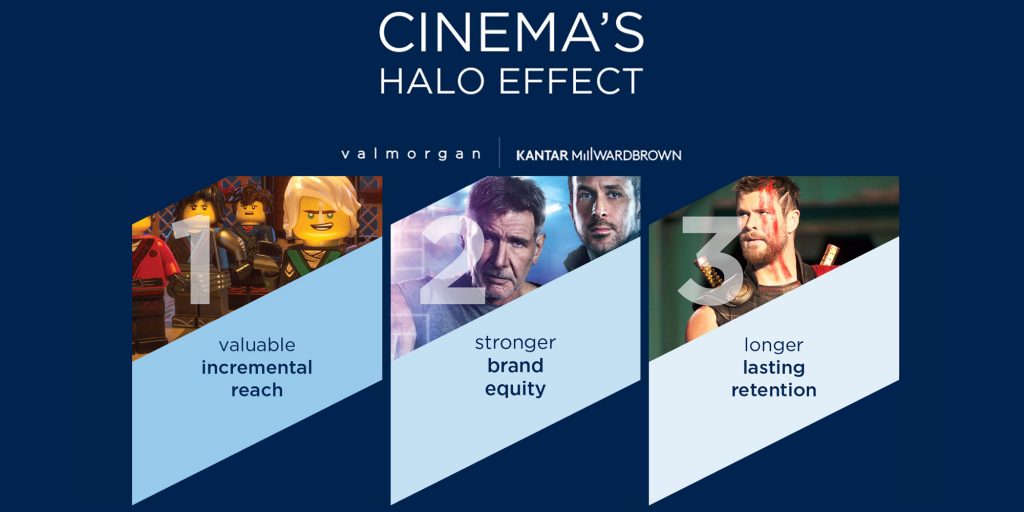
Today, consumers are in full control of what they watch and their options seem endless. This leaves advertisers battling a fragmented environment, declining reach and technology that skips ads. These days it is often difficult to say with confidence that an ad even reached its intended audience or had any impact.
Cinema however, works in a different way to any other media. As evidenced by growing spend, Cinema’s appeal with brands is constantly broadening, as it is providing a powerful way for advertisers to reach audiences – many regard as critical for success.
Consider how cinema advertising is uniquely placed to overcome today’s advertising challenges: The big screen is difficult to ignore. There are minimal distractions. Multi-screening is not socially accepted. Ads cannot be skipped or muted.
With wall-to-wall screens and surround sound in a darkly lit environment, cinema offers an immersive and high sensory experience unlike any other. Because of this, cinema advertising is processed much more consciously and therefore yields results that other advertising mediums cannot.
Cinema has proved to be a powerful and emotionally engaging medium for brands. In the last 12 months 90 million visits have been made to cinemas in Australia, with a third of people in metro areas going to the cinema in the last 4 weeks, so it is a popular channel with consumers as well as being increasingly relevant to marketers.
To help further explore cinema advertising’s effectiveness, reach and engagement, Kantar Millward Brown in partnership with Val Morgan (Motivate Val Morgan’s Business Partner in Australia) undertook research to understand the unique role it plays in a brand’s media allocation.
Kantar Millward Brown CrossMedia – a campaign-based cross- channel brand impact model – was used to generate the insights. Multiple CrossMedia studies were run across key client partners spanning product categories. The results clearly demonstrate that cinema can be a powerful channel to include in the mix.
Cinema’s Added Reach: Over and Above TV and Digital
Consumers are ‘always on’ and more connected than ever which means the battle for attention across screens has never been more fierce. There is little doubt that TV still plays a key role in driving audience reach and brand impact. Yet with the range of TV options combined with consumer behaviour shifting toward multi-screen use, TV has become a fragmented experience.
On the other side, digital is being hailed as the ultimate media for targeting and measurement. With sophisticated tracking and big data customer profiling, targeting should be, and often is, effective and impactful.
Yet digital too, has its limitations. Viewability and fraud are now being closely monitored by many advertisers and video CPMs can rival or even exceed those of TV. Increasingly too, consumers are happy to pay for the privilege to block ads altogether.
With these challenges in TV and digital, advertisers are constantly seeking ways to extend campaigns in new ways, create efficiencies and address gaps in channel strategy.
Kantar Millward Brown research shows that cinema has proved to be a formidable solution, driving incremental reach over and above TV and digital channels. On average across the studies we measured, cinema advertising added approximately 8% incremental reach to each, with 40% of the total cinema reach delivered being incremental to either TV or Digital.
More importantly, cinema advertising also extended exposure to the traditionally hard to reach ‘light TV’ or ‘non-TV’ viewers which helped to balance the frequency distribution across screens. This was seen across age groups, including younger males, amongst whom the ‘light’ and ‘non’ commercial TV viewers represented almost half (46%) of the audience. The value in being able to reach the ‘hard to reach’ for some brands is immeasurable.
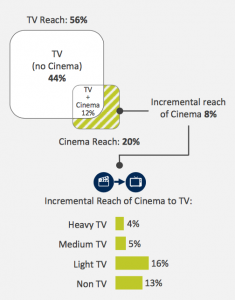
Source: Aggregate across x2 CrossMedia studies
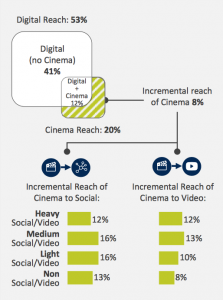
Source: Aggregate across x2 CrossMedia studies
Brand Building with Cinema: Long Term Business Success
Every marketer dreams of building a strong brand that is relevant, trusted and adored. Strong brands underpin profitability and long term business success.
From Kantar Millward Brown’s broader global equity validation study, we know that strong brands capture 5 times more share of volume, command on average 13% higher price premium and have 4 times more potential to grow in the future over weaker brands.
For consumers, strong brands are built on a range of factors: They are more easily recalled (awareness); more readily come to mind with brand imagery (association); and are seen to meet needs, be different to others or in general be more favourable (brand equity). All of these can drive demand (consideration).
In considering these four brand effect measures, from a broader database analysis of over 60 Australia campaigns spanning different categories we have seen that campaigns which have included Cinema out-perform our total database. Whilst we cannot say that the incremental impacts are completely driven by the addition of Cinema, there is indication that having this channel in the mix can help boost brand effects across measures. In particular, we saw the biggest incremental impacts on Equity and Image measures.

Our specific CrossMedia research echoed these results: The brand effects that cinema advertising delivered in these campaigns was more strongly skewed to equity measures overall. And in addition, the contribution of cinema to brand effects was well above its relative share of investment.
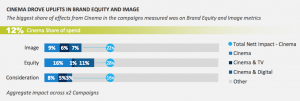
Within the Equity measures that were impacted within the studies, Differentiation metrics of Unique (different to others) and Dynamic (setting trends) were driven most by the activity. Whilst these results are specific to the campaigns measured, they clearly show that Cinema has the capacity to set brands apart from the pack.

Cinema’s Power: Stand Alone & Synergistic Impact
Increasingly the value of a channel is assessed not only by its individual performance but how it performs with other media.
In order to successfully build, optimise and integrate cross- channel strategies, it is vital that marketers understand not only which channels have high impact, but also how and to what degree each plays a role supporting other channels.
From our research, we saw that about half of cinema’s impact was delivered on its own, and an additional half was driven by people seeing ads on cinema plus one other screen. Looking at our broader database, we see that these multi-channel exposure effects play a big role: typically, we see this cross-channel impact, or synergy, contributing on average to between 20-35% of overall brand effects.
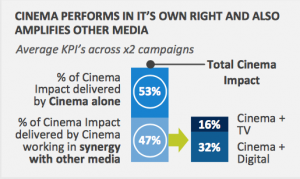
Overall, cinema was shown to be both complementary – as a stand-alone medium that complements other channel metrics – and synergistic with other channels that when combined create a multiplier effect for building brand.
These different approaches can add significant impacts to an overall campaign which can be maximised in the following ways:
Cinema Extends Campaigns: The ‘Rosenate’ Strategy
Resonance emerges as a crucial factor for success for brands looking to build and nurture ongoing, sustainable communications that reinforce brand memories over time.
As well as increasing awareness levels in the short term, the focus of resonance is to consistently and effectively communicate a value proposition and prop up other media efforts in the process.
In the campaigns we measured, there was clear evidence that cinema advertising works extremely well to support a ‘resonate’ strategy. Through intelligent flighting which maximised the way the medium is consumed, Cinema was shown to extend weekly campaign impacts well beyond the flighting of other media had finished.
With the nature of cinema’s reach build and low frequency, our study found that these factors work in favour of a resonate approach, by continuing to generate productive exposure whilst other channels may have more quickly reached a saturation point.
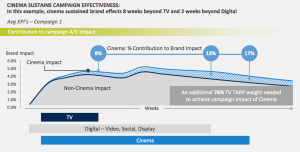
Your Attention Please: Cinema Takes the Lead
The pre-film environment is like no other. For those moments leading into the feature film, there is a heightened sense of anticipation. Cinema holds the attention of a highly engaged and captivated audience who are eager to be entertained and are subsequently more receptive to advertising.
In fact, Cinema has the highest positive receptivity in Australia when compared to other media.
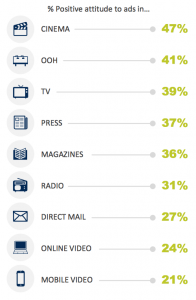
Source: AdReaction 2016, Australia Results based on n=600 16-49s
In line with this, our studies have shown that cinema delivers strong impact per TARP and has high weekly retention over other A/V media – the effects of cinema are retained more strongly week on week compared to other A/V channels. This means that per exposure, cinema outpaces all other forms of A/V media measured in our studies. The cinema environment is a key contributor to the high effectiveness per spot, and the strong and lasting impact that cinema delivers can play well to the resonate strategy mentioned earlier.
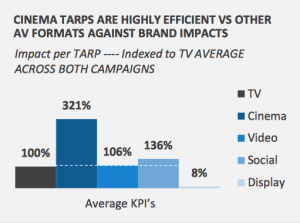
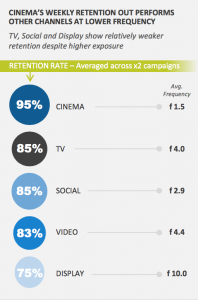
In addition, because cinema offers a channel that is ideal for longer assets, brands have the opportunity to develop and share a meaningful story. Whilst 15 and 30 second spots have been seen to be effective, longer form storytelling is also accepted and welcomed by audiences in the pre-film lead up.
Takeaways for Marketers
With its strength in audience engagement, ability to drive brand effects, and flexibility to both complement and amplify other media touchpoints, we see that cinema is a highly impactful medium.
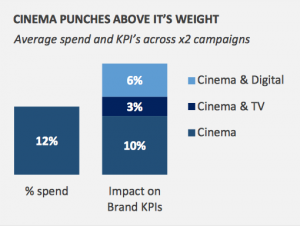
It is also a cost-efficient channel. Our research showed that cinema delivered a higher contribution to campaign impact when compared to the percentage contribution to spend. In fact, without cinema, an average of 20% of the brand effects would not have been realized, compared to 12% share of budget. And where cinema shone the most, impacting on Differentiation, the contribution to metrics were over 3 times more as when compared to investment.
Given the overall findings from our research, the implications for marketers are clear.
In a nutshell:
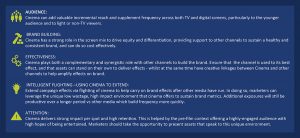
Methodology
Kantar Millward Brown CrossMedia data analysis is rapidly being seen as the global industry standard in multimedia brand measurement. It is designed to evaluate how paid marketing activities affect key brand equity measures such as awareness, engagement and consideration.
The Kantar Millward Brown approach uses a pre- vs in-campaign survey based analysis which controls for any underlying involvement factors (such as previous category interest and purchase behaviour) and ongoing influences (such as word of mouth or news coverage). This allows it to uncover the campaign’s true influence on top of these other factors.
By understanding when marketing activity was running and what the media consumption habits of consumers were, Kantar Millward Brown is able to see how each media channel individually and synergistically contributes to audience delivery and impact on brand metrics.
Access the whitepaper here.
Sources: Val Morgan and Kantar Millward